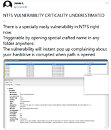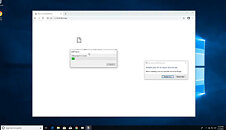Monday, January 18th 2021

Critical Flaw in Windows 10 Could Corrupt Your Hard Drive
Windows OS security is taken seriously, as the OS is wide-spread across millions of PCs around the world, however, there may be issues where OS has some security flaw that is found by external researchers. Due to the sheer code base of the new OS like Windows 10, there are a plethora of bugs and security flaws waiting to get discovered by someone. And today, thanks to the team of cybersecurity researchers, we have found out that in Windows 10 file-system called NTFS, there is a bug that corrupts your hard drive by simply triggering a specific variable name in a file.
If the end-user inside Windows 10 tries to access the NTFS attribute called "$i30" in a specific way, the flaw is exploited. The NTFS search index attribute, specifically the string "$i30", is containing a list of files and subfolders in a directory, and there is even a log of deleted files and folders. After running a specific command inside the command line (CMD) or inside the browser, Windows will start to display warnings of "File or directory is corrupted and cannot be read". After that, the OS will prompt a user to restart the machine and repair the damaged drive, so the Windows disk check utility will start. Once corrupted, Windows 10 will start displaying a notification indicating that the main file table (MFT) on the particular disk is corrupted and thus can not operate. Starting from the build Windows 10 Build 1803 the OS is vulnerable until the current version and a possible fix is expected to be released soon.
Sources:
Jonas L (Twitter), Siam Alam (Twitter), via Security Newspaper
If the end-user inside Windows 10 tries to access the NTFS attribute called "$i30" in a specific way, the flaw is exploited. The NTFS search index attribute, specifically the string "$i30", is containing a list of files and subfolders in a directory, and there is even a log of deleted files and folders. After running a specific command inside the command line (CMD) or inside the browser, Windows will start to display warnings of "File or directory is corrupted and cannot be read". After that, the OS will prompt a user to restart the machine and repair the damaged drive, so the Windows disk check utility will start. Once corrupted, Windows 10 will start displaying a notification indicating that the main file table (MFT) on the particular disk is corrupted and thus can not operate. Starting from the build Windows 10 Build 1803 the OS is vulnerable until the current version and a possible fix is expected to be released soon.


124 Comments on Critical Flaw in Windows 10 Could Corrupt Your Hard Drive
Security for one of their own lame apps I don't use and likely would love to uninstall if I haven't already lolHi,
10 is never out of beta stage is one beta after another.
MS externally Forcing an untimely reboot on a private machine, without owner agreeing to it, to a new OS build, causing loss of time and work and potentially farking a machine. Do not agree with that. It’s pretty shady ethically and legally.
So, the question should be, what method could be designed to enforce the updating of machines without forcing reboots that have not been agreed to. There are a thousand different ways to make that work.
Yet I'm still on win-7 and the world hasn't ended without that patch plus any spectre/ meltdown nonsense either :-)
It usually winds up being too late to do anything about the brick sitting next to the lava lamp you have sitting on your RGB embedded computer desk, guess they'll learn next time and be more sensible, right? :shadedshu:
Nope just a bad example of yours really but I do have a gun carry permit = Check ;)
There is more to security than os patches and MS browser which have always been targets
Remote access..... disabled = Check
Mbam Pro license = Check
Ublock Origin browser security = Check
Don't use MS apps = Check
I have deferred updates countless times, set my active hours to when I'm actually using the PC, and never had a single automatic reboot. I occasionally have updates running in the background, but when they're done, I get a reminder that my PC will need a restart as soon as I'm ready. That's it.
I've been using Windows 10 basically since day one, so I know what I'm talking about. Those people that you refer to are either using an ancient version (pre-1809), or haven't changed the settings that they need to change. The picture I posted is an actual screenshot from the update settings. If you set it to off, you will no longer experience the random restart syndrome. Magic.
Old Windows OSes didn't give you anything, you had to install and configure everything yourself. Windows 10 gives you a basic set of apps and settings. If you don't like them, change them. Don't be lazy.1. Drawing any sort of conclusion about humanity as a whole ignores the infinite number of individual differences, and as such, is totally pointless and false.
2. You are describing 'attitude', which is an individual variable, and has nothing to do with the fact that using a PC and the internet requires some basic knowledge. Like I said above: just because you don't know about certain things, it doesn't mean that you shouldn't care to know about them.
Like I said before:
You kinda failed to sell your argument there.
Microsoft has MORE than it's share of problems, but the NTFS file system isn't one of them.
You can't handle the truth lol
A while back Ars Technica wrote an interesting article about that:
arstechnica.com/information-technology/2014/01/bitrot-and-atomic-cows-inside-next-gen-filesystems/